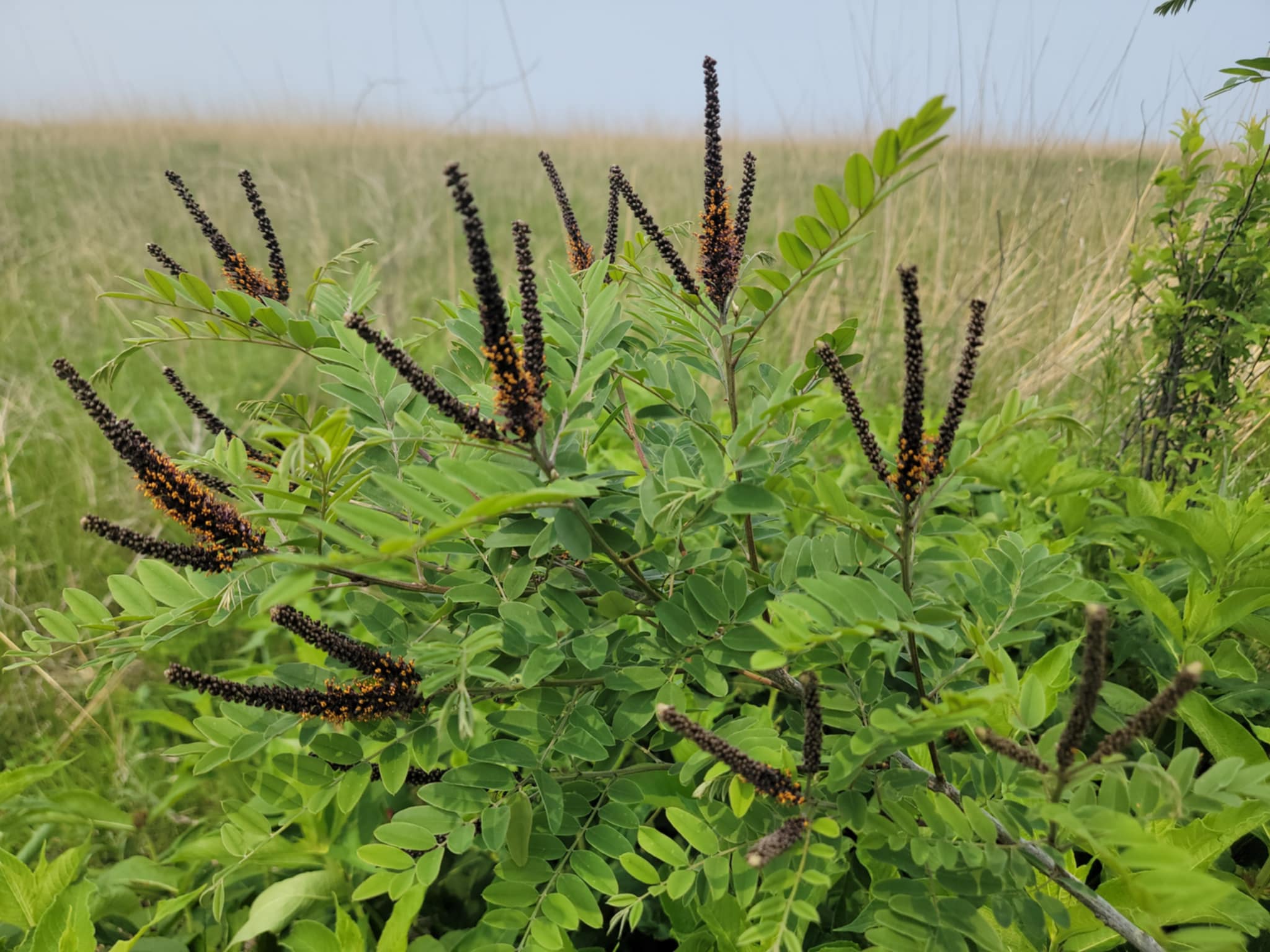Katie Byerly of Cerro Gordo County is also known as Iowa Prairie Girl on YouTube.
It’s a legume, it’s a bush, it’s an insect pollinator and bird habitat, and in the Midwest it’s a native wildflower.

The small deep-purple flowers of false indigo (Amorpha fruticosa) are packed close together on a 3-8 inch spike-like raceme. Each flower is just one petal. This petal type is called a standard. Each little flower is approximately 1/4 inch long, and it wraps around into a tube, bundling the reproductive organs into a beautiful bouquet. Ten beautiful, bright orange-yellow stamens jut out from their violet-colored swathe.


Each individual flower in and of itself is charming, but thousands of these brillant beauties together creates an eye-catching and stunning sway. False indigo’s inflorescene is similiar to its cousin Leadplant. The Illinois Wildflowers website describes false indigo as “Leadplant on steroids.” The two legumes have several similiarities, but everything on False indigo is bigger: longer racemes, bigger leaflets, and it is much, much taller. (Click here for images of leadplant.)

Many times the spike-like racemes present in groups of three.

False indigo is a bush. Young plants may only be a few feet tall, while a mature plant may tower in the prairie or riverbank at 12 or 16 feet or even 20 feet.
It prefers wet or moist soil and is often found along the edges of ponds, riverbanks and wet prairies. During a recent trip to Lewis and Clark State Park (Monona County, in western Iowa), I found false indigo growing next to the boat ramp.

False indigo at Lewis and Clark State Park
However, on that same day I stopped at a prairie closer to home in Franklin County and found False indigo growing tall and strong on Franklin County’s highest elevation, near the town of Sheffield.


False indigo also grows at my favorite local haunt: Wilkinson Pioneer Park in Rock Falls (Cerro Gordo County). I find small stands of false indigo around the pond and along the Shell Rock river. However, the larger stands are in the prairie. Depending on the weather, the prairie ground may be dry but often the ground will be soggy and the plant is not the only one with wet feet (and wet dogs).
I have noticed that the false indigo at Wilkinson park is spreading. False indigo is a native wildflower in the Midwest; however, in the Eastern and Western parts of the United States transplants are considered invasive.
The flower’s peak bloom in Cerro Gordo county is in June. You might find it blooming as early as May and as late as July. The plant prefers sunny areas. With all those small flowers, the plant provides nectar and pollen to small bees and insects. Caterpillars, butterflies, and moths feed on the foliage and flowers.

False indigo has light gray-green leaflets. Its fern-like foliage resembles its other relations in the legume/pea family.

Minnesota Wildflowers describes them as follows:
Leaves are compound in groups of 11 to 25, alternately attached at the main stem. Leaflets are generally oval, rounded at both ends, to 1½ inch long and ¾ inch wide, and toothless. They can be hairless or hairy to varying degrees.

Each leaflet has a tiny, pointed tip.

The lower, tall stems of the bush are woody with smooth gray bark.

The size and overall bushiness of false indigo provides for shady habitat and cover to upland birds and animals in the open prairie.

Each of those little tubular flowers creates a tiny seedpod. Each seedpod contains 1-2 seeds.
This image of the seedpods comes from the Kansas Wildflower and Grasses website.

Historically Native Americans and early settlers used false indigo for its blue dye. However it does not produce as much or as bright a blue dye as does True indigo from Asia. Other common names for Amorpha fruticosa are Bastard indigo, River locust and Wild indigo.
The flowers bloom for two to three weeks. The vibrant colors begin to fade after the peak bloom. If you catch false indigo bush in full bloom, its bright contrasting colors are sure to bring a smile to your face and a “Wow!” to your lips.



3 Comments
Thanks
I haven’t seen these beauties around my area of eastern Iowa but that only means I haven’t looked hard enough?
General question tho: I have a rather larger patch of wild ginger growing under my spruce trees. Should I allow it to spread or try and remove it?
BettScott Wed 11 Jun 8:13 PM
No title
Wild ginger is a native plant and isn’t aggressive in my experience, so I would leave it there. It does well in the shade.
More about wild ginger, via Lora Conrad:
Laura Belin Thu 12 Jun 4:18 PM
False indigo is indeed gorgeous -- thanks for this great post!
Like many native plants, false indigo may grow where humans plant it, do well for several years, and then disappear if the planting site wasn’t really suitable. I’ve seen that happen. That is one reason why planting a very diverse mix of native seed that is truly native to the planting area can be a good way to create a quality planting that lasts over time. A diverse mix can give each plant species the opportunity to find good places to grow.
This post also contains a valuable reminder that the word “native” needs to be considered carefully, especially when used commercially. Some nurseries, especially some native-plant nurseries, are ecologically knowledgeable and generously informative to their customers. Some other nurseries, however, use the word “native” to mean “this plant is native to some part of North America, we are pretty sure.” For customers, that may not work out so well.
PrairieFan Wed 11 Jun 8:38 PM